
How to Audit and Optimize Your Internal Link Structure
Checking & improving the links within your website is key for better search engine results and keeping users interested. Start by evaluating your existing link structure. Utilize tools such as Google Search Console and Screaming Frog. Identify gaps and broken links through these tools. Analyzing link performance through metrics such as click-through rates and conversion rates will provide insights into effectiveness. Fixing broken links and ensuring contextual relevance improve both navigation and SEO. Regularly update and strategically place links, directing users to high-value content. Utilize a carefully planned linking approach that adheres to search engine optimization guidelines. This will boost your website’s credibility and enhance the user’s overall experience. To uncover more strategies, explore the nuances of linking optimization.
Key Takeaways
- Use tools like Screaming Frog or Ahrefs to identify broken links and assess internal link structure.
- Conduct regular audits to evaluate link performance metrics such as click-through rates and user engagement.
- Ensure contextual relevance by placing links where they naturally fit within the content for enhanced navigation.
- Optimize anchor text with descriptive language to clearly convey linked content’s purpose to users and search engines.
- Regularly update links to reflect content changes and prioritize high-value pages for improved SEO authority.
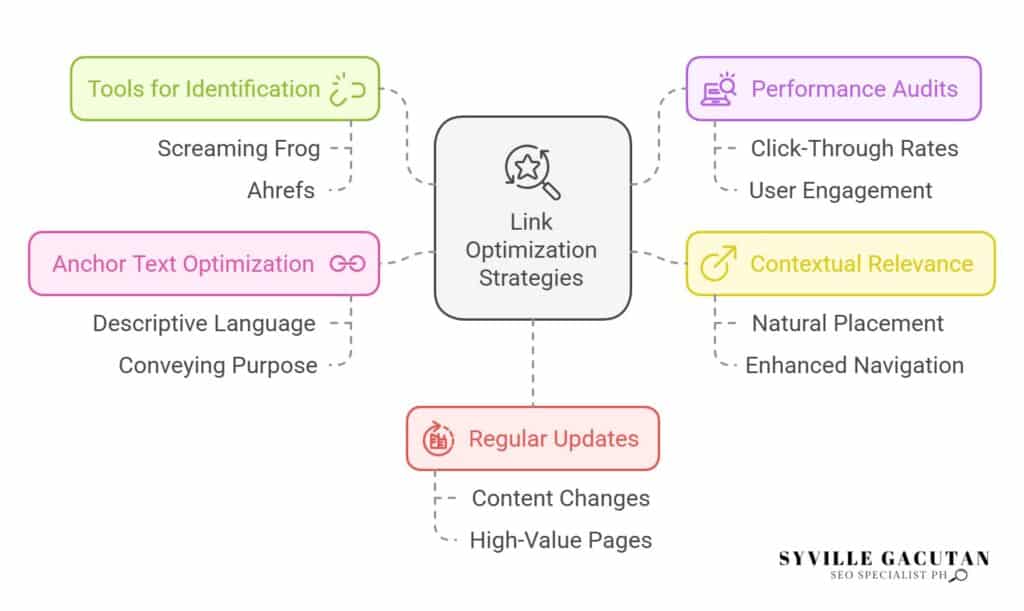
Understanding Internal Links
Links within a website form the core structure. They impact how users navigate the site & influence search engine rankings. Proper internal linking improves the overall experience for visitors and search engines alike. By connecting related content, internal links guide users through a website, making it easier for them to find information and engage with additional content. This strategic navigation not only improves user engagement but also signals to search engines the importance and relevance of linked pages, influencing their ranking.
Understanding the internal linking structure of a website is essential for maximizing its potential. An effective internal linking strategy involves a well-organized hierarchy where crucial pages receive more links, indicating their significance. Examining the internal links thoroughly can uncover flaws and vulnerabilities in the existing structure. This process provides valuable information about areas that need enhancement. This audit assesses the flow of link equity throughout the website, ensuring that no page is isolated or underutilized.
The importance of internal linking cannot be overstated. It provides an opportunity to distribute authority and value across the website, reinforcing the content’s thematic relevance. This, in turn, enhances the website’s credibility and discoverability in search engine results.
Identifying internal linking opportunities is crucial for optimizing a website’s internal linking structure. By analyzing user behavior and content performance, webmasters can determine which pages would benefit from additional links. This strategic enhancement fosters a more cohesive user journey, ensures critical content is easily accessible, and supports overall site goals.
Benefits of Internal Linking
A well-structured internal linking strategy offers numerous benefits that significantly impact both user experience and search engine optimization. By strategically connecting related content within a website, internal links enhance navigation, allowing users to seamlessly discover important pages. This improved accessibility not only keeps visitors engaged but also encourages them to spend more time on the site, reducing bounce rates and increasing the likelihood of conversions.
From an SEO perspective, internal linking plays a crucial role in distributing link equity across a site. This distribution ensures that authority is appropriately shared among pages, helping to elevate the visibility of important pages in search engine results. By prioritizing links to high-value content, websites can guide search engine crawlers more effectively, promoting better indexing and ranking of relevant pages.
Moreover, internal linking contributes to a more organized site architecture, which is beneficial for both users and search engines. A coherent structure aids search engines in understanding the relationships between pages, thereby enhancing SEO performance. This clarity allows search engines to crawl and index content more efficiently, ultimately leading to improved search engine optimization.
Additionally, a well-implemented internal linking strategy supports content promotion and helps highlight priority pages. By directing users and search engines to important pages, businesses can ensure that their most valuable content receives the attention it deserves. This approach not only strengthens the overall SEO framework but also fosters a cohesive user journey, aligning with business goals and enhancing the overall digital presence.
Identifying Your Current Structure
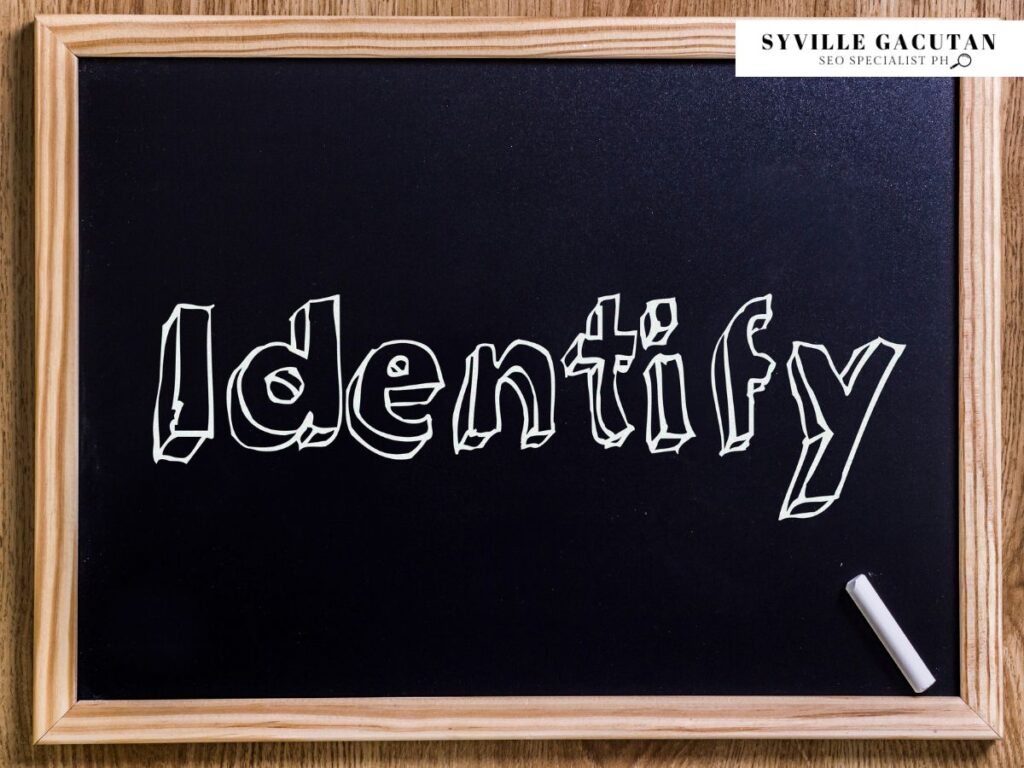
To effectively audit internal links, it is crucial to first understand the existing structure of your website. An internal linking audit begins with mapping out your site’s internal linking structure to ensure that important pages receive the attention they deserve. Understanding how links across your site are distributed can help you identify potential improvements that could enhance both user experience and search engine rankings.
One approach to identifying your current structure is to categorize pages based on their role and importance. This involves evaluating which pages are central to your site’s purpose and ensuring they are adequately linked from other parts of your site. For a clearer picture, consider the following table that outlines potential categories for your pages:
| Category | Description | Importance Level |
| Home Page | Central hub for navigation | High |
| Main Category | Key sections representing core topics | High |
| Subcategory | More specific topics under main categories | Medium |
| Informational | Blog posts or articles providing detailed insight | Medium |
| Support/Contact | Pages assisting user inquiries or support | Low |
This breakdown allows you to see where your focus should be when evaluating links. Important pages, such as the home page and main category pages, should receive more internal links to emphasize their relevance to search engines. By examining the current linking patterns, you can identify gaps where essential pages may lack sufficient connections, which could negatively impact their visibility.
Tools for Link Auditing
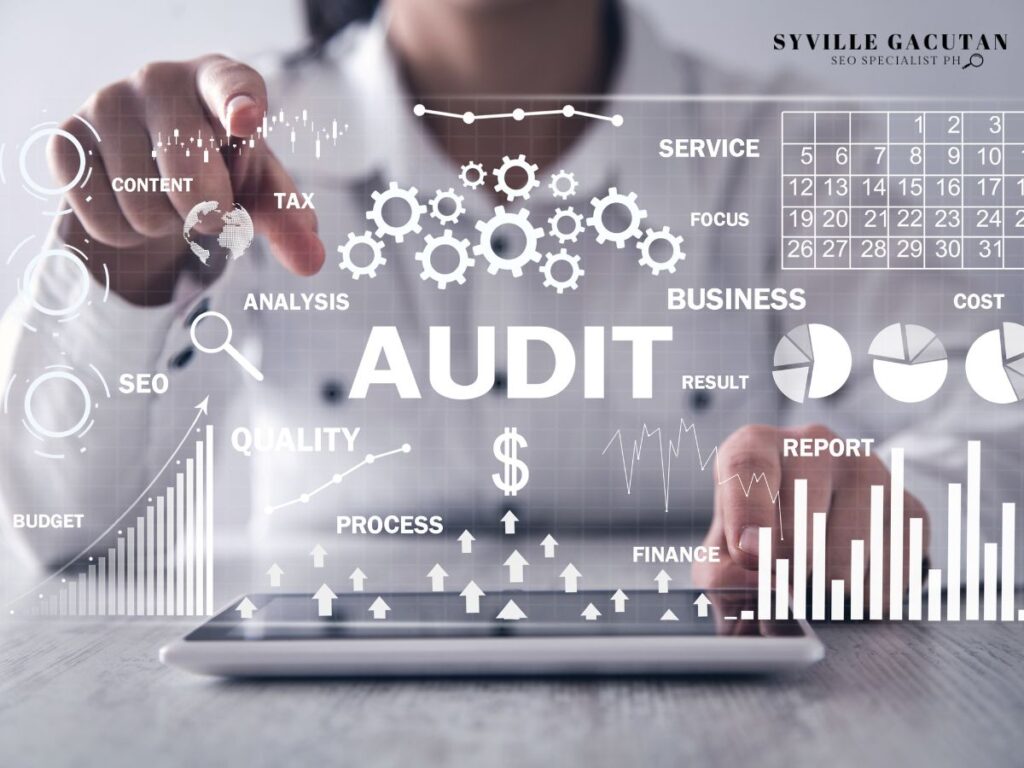
Having established an understanding of your website’s internal linking structure, employing the right tools can significantly enhance the efficiency and accuracy of your audit process. Tools like Google Search Console are indispensable for webmasters aiming to optimize their sites. Google Search Console provides detailed insights into your internal linking structure, offering data on how search engine bots perceive and index your website. This tool is particularly beneficial for identifying pages that might be receiving less attention and adjusting your strategy to distribute link juice throughout your site more effectively.
In addition to Google Search Console, there are specialized tools designed to facilitate comprehensive audits. For instance, Screaming Frog SEO Spider is a robust application that crawls your website in a manner similar to search engine bots. It reveals broken links, redirects, and areas where internal linking could be improved, thereby offering actionable insights to fortify your internal linking strategy.
Moreover, Ahrefs and SEMrush are valuable resources that provide in-depth analysis of your internal links. These tools offer visualization features to help you map out your site’s link architecture, enabling a clearer understanding of how link juice flows across your pages. By employing such tools, you can ensure optimal connectivity within your site, enhancing user experience and search engine optimization.
Ultimately, selecting the appropriate tools like those mentioned above allows for a more systematic approach to auditing your internal links. This ensures that your website maintains an efficient structure that supports both users and search engines, fortifying your site’s overall performance and visibility.
Analyzing Link Performance

When evaluating the effectiveness of your internal linking strategy, how do you determine which links are contributing positively to your site’s performance? Conducting a thorough internal linking audit is crucial to analyze link performance and discern the value each link adds. This process involves assessing metrics such as click-through rates, time on page, and conversion rates to identify the links that are enhancing user engagement and supporting your SEO objectives.
To improve your internal linking strategy, consider creating a comprehensive table that captures key performance indicators of your links on your website. This will help in visualizing their effectiveness:
| Metric | Description | Importance |
| Click-through Rate (CTR) | Measures the percentage of users clicking on the link | High CTR indicates engaging and relevant anchor text |
| Time on Page | Tracks how long users stay after following a link | Longer times suggest valuable content and effective links |
| Conversion Rate | Percentage of users completing a desired action | High conversion rates reflect successful link pathways |
Analyzing these metrics allows you to pinpoint which links are driving meaningful interactions and which may require adjustments. Relevant anchor text plays a pivotal role here, as it ensures the context of the link aligns with the user’s intent, thereby increasing the likelihood of engagement.
Furthermore, prioritize links that naturally fit into the content and guide users seamlessly through the site. As you refine your internal linking strategy, continue to monitor these metrics to ensure sustained performance improvements. By systematically leveraging this data, you can optimize your internal link structure, ultimately enhancing user experience and boosting your site’s overall SEO performance.
Best Practices for Link Placement

Optimal link placement is a cornerstone of an effective internal linking strategy, as it directly influences user navigation and search engine understanding of your site’s structure.
Properly placed links can significantly enhance the internal linking structure, ensuring that both users and search engines can easily identify and navigate to relevant pages. This, in turn, optimizes user experience and boosts SEO performance.
To achieve the best results, consider the following best practices for internal linking:
- Contextual Relevance: Place links in areas of content where they naturally fit and provide additional value. This not only assists in guiding users to related content but also signals to search engines the interconnectedness of your content.
- Strategic Placement: Focus on placing links within the main body of the text, where they are most likely to be clicked. Links in headers, footers, or sidebars are often ignored by users and carry less SEO weight.
- Anchor Text Optimization: Use descriptive and relevant anchor text that accurately represents the linked page’s content. This helps users understand what to expect and provides search engines with context.
- Prioritize High-Value Pages: Direct more internal links to high-value pages, such as cornerstone content or key product/services pages. This helps distribute page authority effectively and enhances the visibility of crucial pages.
Fixing Broken Links
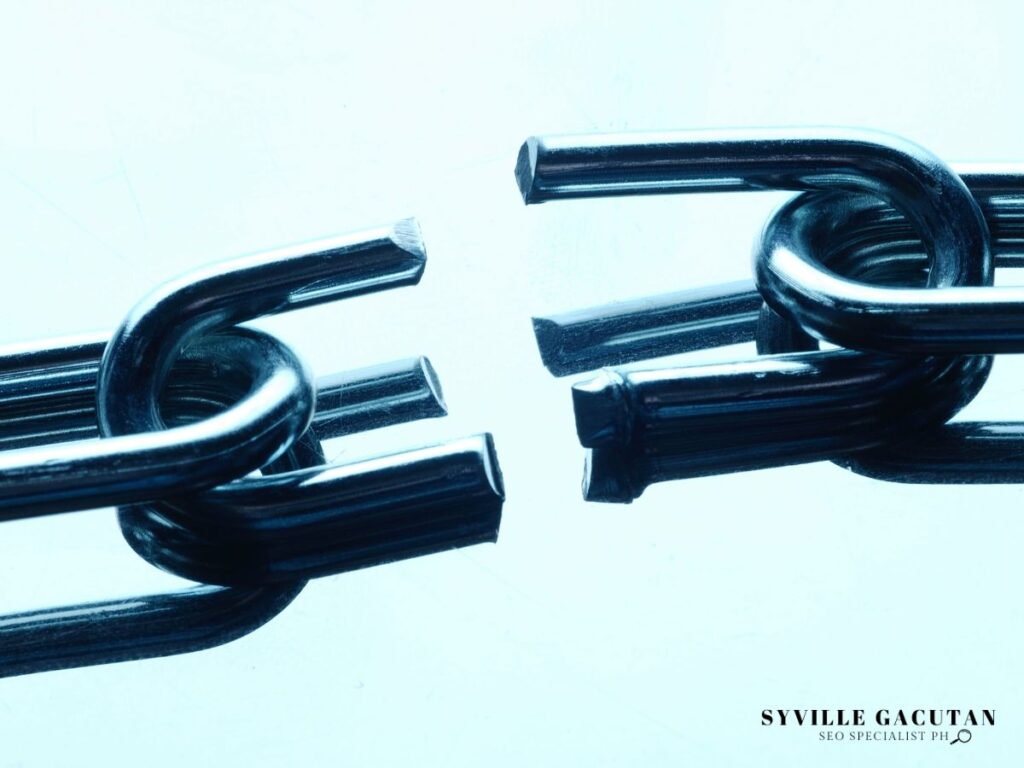
Addressing broken links is an essential aspect of maintaining a robust internal linking structure. Broken links can significantly hinder user experience, disrupt the flow of your content, and negatively impact your site’s SEO. Conducting a comprehensive internal linking audit is the first step toward identifying and rectifying these issues. By systematically reviewing your site’s internal links, you can pinpoint those that are no longer valid and take effective corrective measures.
Once broken links are identified, the next critical step is to determine whether they should be replaced or removed entirely. Removing links that lead to non-existent pages will help prevent user frustration and maintain the credibility of your site’s internal navigation. However, when possible, replacing broken links with updated, relevant URLs can preserve the value of the original internal link and continue to boost your site’s SEO efforts.
Utilizing specialized tools to automate the detection of broken links can streamline the internal linking audit process. These tools efficiently crawl your site, generating comprehensive reports that highlight problematic links. Armed with this information, you can systematically address each broken link, either by updating it or deciding to remove links that no longer serve a purpose.
Ultimately, fixing broken links is not just about maintaining the integrity of your site’s internal structure; it is also about optimizing the user experience and enhancing search engine rankings. By ensuring your internal linking strategy is free of broken links, you contribute to a seamless navigation experience, which can significantly boost your site’s overall performance and credibility.
Enhancing Link Relevance
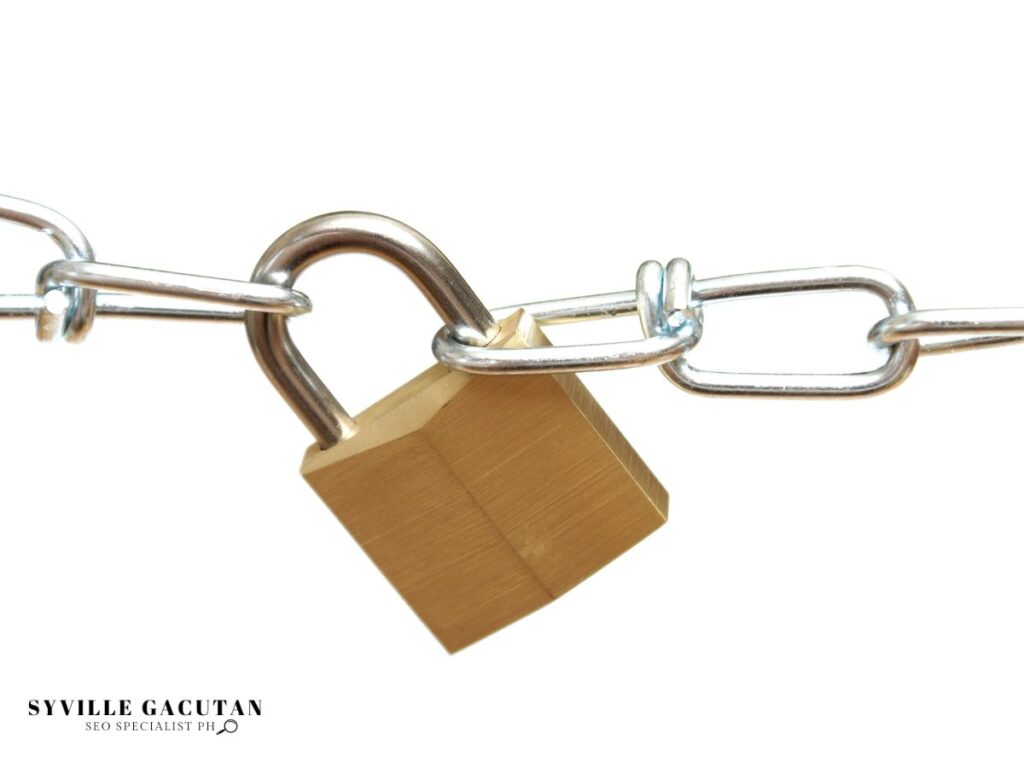
Enhancing link relevance is a critical aspect of refining your internal linking strategy to align with both user intent and search engine algorithms. By focusing on link relevance, you ensure that your links serve a purpose beyond mere connectivity, thus improving the overall user experience and ultimately, your site’s SEO performance.
An effective internal linking audit can help identify opportunities to enhance link relevance within your website. Here are a few strategies to consider:
- Focus on Contextual Links: Ensure that links are placed within a meaningful context, providing additional value to the reader. Contextual links help search engines understand the relationship between pages, increasing the visibility of linked content.
- Use Descriptive Anchor Text: The anchor text should accurately describe the content of the linked page. This not only guides users but also aids search engines in determining the relevancy of the link, which can improve your SEO.
- Distribute Links Across Relevant Pages: Avoid clustering all links on a single page. Instead, distribute them across various relevant pages to create a network of interconnected content that enhances the user’s journey and the crawlability of your site.
- Regularly Update Links: As your content evolves, regularly update links to reflect changes. This ensures that all links across your site remain relevant and useful, thus maintaining the integrity of your internal linking structure.
Creating a Linking Strategy

Developing a robust internal linking strategy is essential for optimizing your website’s navigation and improving SEO outcomes. To create an effective internal linking structure, it is necessary to first perform an internal linking audit. This involves analyzing existing links to identify gaps or redundancies that could impede the flow of link equity across important pages on your site. By strategically connecting content, you can enhance user experience, facilitate indexation by search engines, and ultimately boost your site’s performance.
An internal linking strategy should prioritize key pages that play a crucial role in your seo strategy. These might include landing pages, high-value content, or conversion-oriented pages. Ensure that these important pages on your site receive sufficient link equity through internal links, as this can significantly improve their search engine rankings.
To assist in visualizing and planning your internal linking strategy, consider using a simple table to categorize and prioritize link placement:
| Page Type | Linking Priority | Actions Needed |
| Landing Pages | High | Increase internal links |
| Blog Content | Medium | Balance internal and external |
| Low-Traffic Pages | Low | Reduce or repurpose links |
Effective internal linking also involves maintaining a natural flow of information. Avoid excessive linking, which can dilute link value and confuse users. Instead, focus on meaningful connections between pages. By thoughtfully curating your internal linking structure and performing regular audits, you can sustain a coherent and dynamic website that supports both user engagement and SEO objectives.
Monitoring and Updating Regularly

To maintain the efficacy of your internal linking strategy, consistent monitoring and updating are imperative. Regularly evaluating your website’s internal linking structure ensures that you sustain the SEO value of your efforts and adapt to any changes in your website’s content or architecture.
As your site evolves, some internal links across pages may become obsolete or require optimization for improved user experience and search engine performance. Therefore, a proactive approach to monitoring and updating is essential.
Begin by employing tools that can effectively crawl your website to identify broken or outdated links. Such tools can help you generate comprehensive reports on the status of your site’s internal links, enabling you to address issues promptly.
Here are some actions to consider:
- Leverage Analytics: Use web analytics tools to assess how users are navigating your site through internal links. This insight can highlight which links are performing well and which need enhancement.
- Update Content Regularly: Ensure that your internal links lead to relevant, updated content. Outdated content can diminish user experience and lower SEO value.
- Optimize Anchor Texts: Regularly review and refine anchor texts to ensure they are descriptive, relevant, and varied. This enhances both user understanding and SEO.
- Check Link Depth: Analyze the link depth of crucial pages within your website’s internal linking structure. Key pages should be easily accessible, ideally within a few clicks from the homepage.
Final Thoughts
Optimizing your internal link structure is a continuous process that significantly impacts both user experience and SEO performance. By regularly auditing your links, utilizing the right tools, and strategically placing relevant links within your content, you can enhance site navigation, improve search engine rankings, and guide users to your most valuable pages. With a well-maintained internal linking strategy, you not only streamline user engagement but also ensure that your website remains discoverable and authoritative in search results.
If you’re ready to take your website’s internal linking and SEO strategy to the next level, connect with Syville Gacutan, a skilled SEO Specialist in the Philippines. Syville can help you optimize your website’s structure, enhance user experience, and boost your search engine visibility. Don’t leave your SEO success to chance—partner with an expert who understands the intricacies of internal linking and on-page optimization.